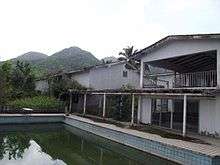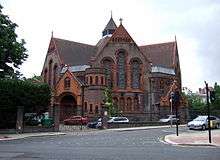Associated Independent Recording
Associated Independent Recording (AIR) is an independent recording company founded in London in 1965 by record producer Sir George Martin and his business partner John Burgess,[1] after their departure from Parlophone.[2] The first album produced by George Martin by his new company was the Beatles' Rubber Soul, recorded at Abbey Road Studios.
The leading independent recording studio complex was founded in 1969. Since then AIR has operated its own professional audio recording facilities, AIR Studios.[2]
Oxford Street – London (1970–1991)
AIR's first facility opened on 6 October 1970. It was located on the fourth floor of 214 Oxford Street, containing four studios and (later) a MIDI programming room. The facility included two large studios (one 58×32 feet, the other 30×28 feet) and two small ones. The studios contained two Bösendorfer pianos, many soundproof booths, and a 56-channel mixing console, custom-designed by Neve Electronics to AIR's specification.[2] Many artists recorded there, including the Pretenders for their 1984 album Learning to Crawl.[3]
AIR Montserrat (1979–1989)

The company built another recording studio on the Caribbean island of Montserrat which opened in July 1979. The first album cut in the newly opened studios was Real to Reel by the Climax Blues Band in 1979.
Jimmy Buffett recorded Volcano at the Montserrat studio in May 1979, naming the album and its title song for the then dormant Soufrière Hills volcano on the island. Elton John recorded three albums at the Montserrat studio in the 1980s. Dire Straits recorded their highly successful Brothers in Arms album between 1984 and 1985. Other well-known studio clients[4] included: the Police (Ghost in the Machine and Synchronicity), Ultravox, Orchestral Manoeuvres in the Dark (Pre-recorded Junk Culture), Paul McCartney, Marvin Gaye, Gerry Rafferty, Rush, The Rolling Stones, Black Sabbath, Midge Ure, Little River Band, Duran Duran, Sheena Easton and Luther Vandross.
In 1986, the studio equipment list read, in part:
- "Recently refurbished control room now featuring 60 channels by SSL with automation and TR and 12 fully integrated channels by Rupert Neve of Focusrite, two 32track Mitsubishi X850 digital machines and 24track Studer A800. Digital mixing on two Mitsubishi X86. Very comprehensive ancillary equipment list."
In 1989, shortly after the Rolling Stones had recorded their Steel Wheels album, Hurricane Hugo devastated the island; the Montserrat facility was severely damaged, and was forced to close.
According to George Martin,[5]
Before we came to Montserrat there was no western music to speak of on the island. Building AIR meant that many leading recording artists came to stay. It cast its spell on them as they mingled with the local people. It was and still is a unique place... After ten great years of recording there the music business had changed. The moguls running the business no longer wanted their artists miles away, outside their control. That coincided with the devastation caused by the hurricane and sadly the studios had to close. The people of Montserrat are still very proud of the work that was done at AIR Studios.
The studio buildings are still standing but their roofs are failing, leading to extensive damage to the floors of the accommodation area and inner part of the studio complex, making them unsafe to walk on. The facility is now a modern ruin and is closed to the public.
The buildings are located at 16°44′28″N 62°12′53″W.
AIR Lyndhurst Hall, Hampstead (1991–present)

In 1991, with the lease on the Oxford Street premises coming to an end, AIR Studios took over Lyndhurst Road Congregational Church, a Grade II listed building designed in 1880 by Victorian architect Alfred Waterhouse and located in the Hampstead suburb of north London. The space was revamped as a recording facility and opened for business in December 1992. AIR Lyndhurst is now a key London facility for classical and popular recordings, as well as film scores, television post-production, and dialogue, sound effects and music for video games. Employees include Olga Fitzroy.[6]
References
- Eugene Chadbourne. John Burgess at AllMusic
- "AIR Studios". Facebook.com. Retrieved 28 April 2019.
- Buskin, Richard (5 September 2005). "CLASSIC TRACKS: The Pretenders 'Back On The Chain Gang' Producer: Chris Thomas • Engineer: Steve Churchyard". Soundonsound.com. SOS Publications Group and/or its licensors. Archived from the original on 22 April 2019. Retrieved 17 December 2019.
- "Throwback Thursdays: Story of Montserrat AIR Studios & Dire Straits". DireStraits. 2017-08-24. Retrieved 2020-01-30.
- Hastie, Paul (2014-03-27). "BBC News – Why do the children of Montserrat sing about a volcano?". BBC News. Retrieved 2014-07-25.
- https://www.bbc.co.uk/programmes/p07y64hl